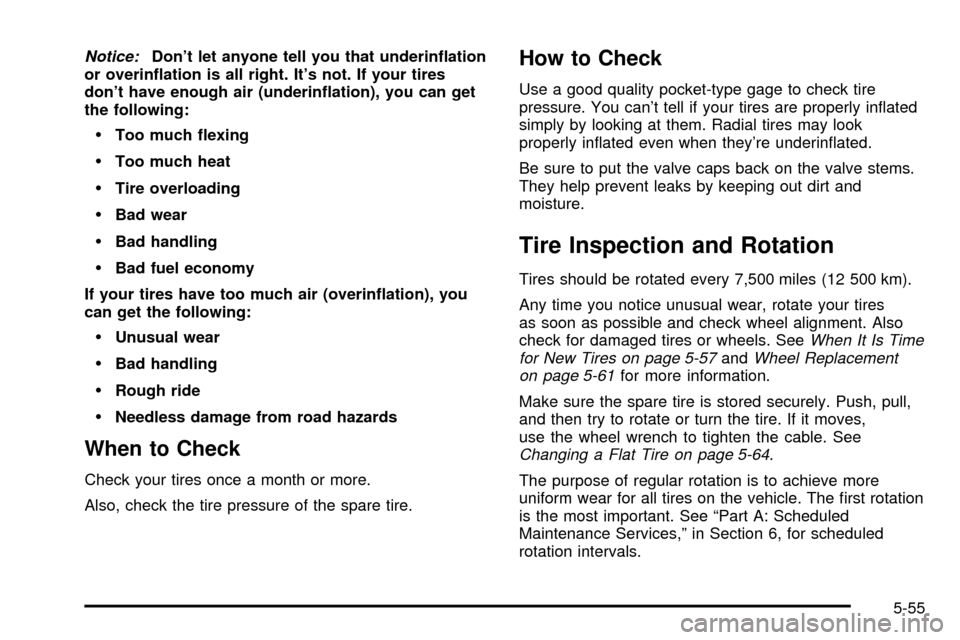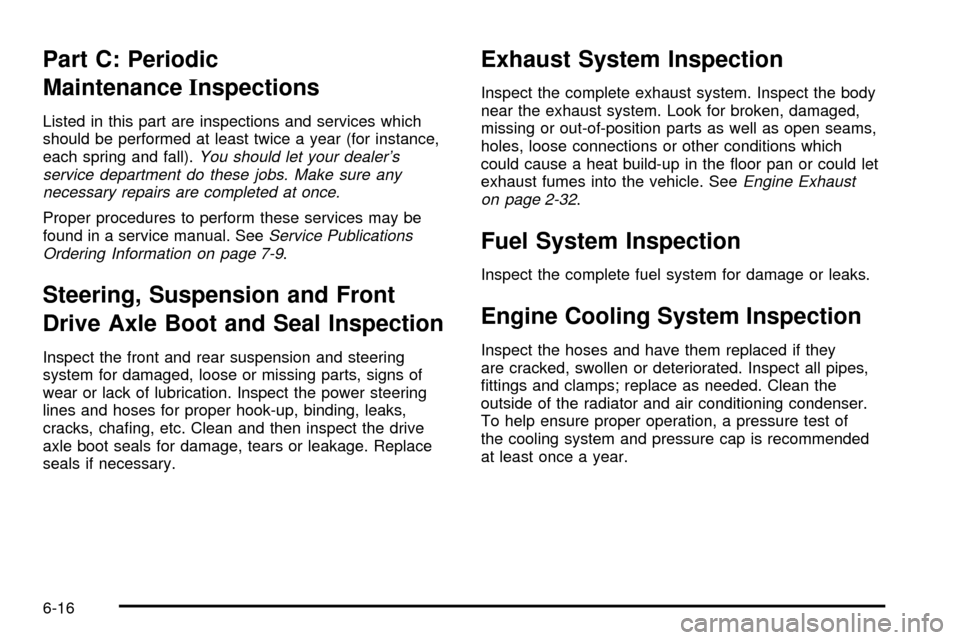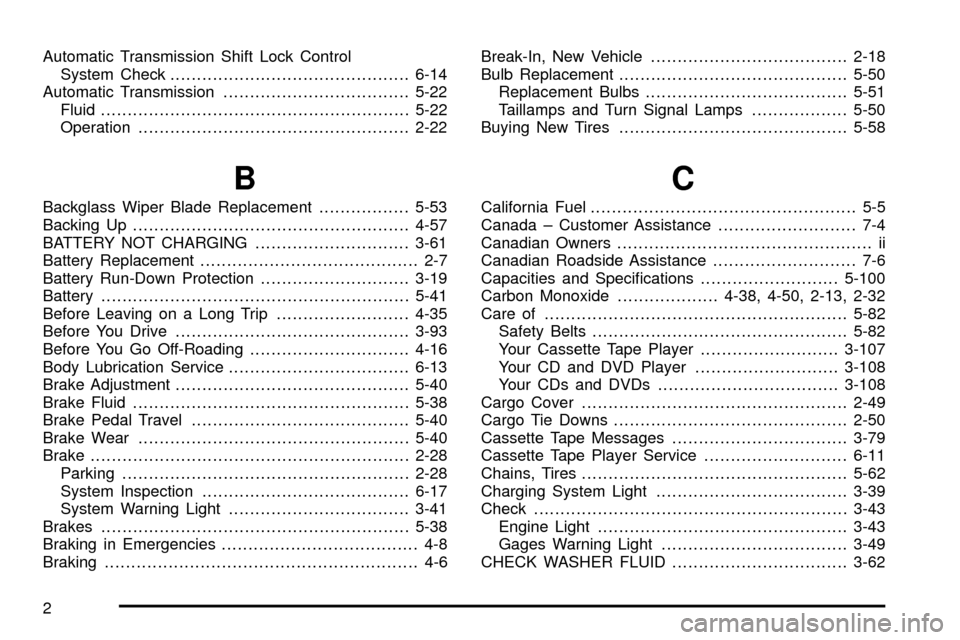Page 321 of 436

6. Start the engine and let it run until you can feel the
upper radiator hose getting hot. Watch out for the
engine cooling fan.
7. By this time, the coolant level inside the radiator
®ller neck may be lower. If the level is lower, add
more of the proper DEX-COOL
žcoolant mixture
through the ®ller neck until the level reaches
the base of the ®ller neck.
8. Then replace the pressure cap. At any time during
this procedure if coolant begins to ¯ow out of the
®ller neck, reinstall the pressure cap. Be sure
the pressure cap is hand-tight.
Engine Fan Noise
This vehicle has a clutched engine cooling fan. When
the clutch is engaged, the fan spins faster to provide
more air to cool the engine. In most everyday driving
conditions the clutch is not engaged. This improves fuel
economy and reduces fan noise. Under heavy vehicle
loading, trailer towing, and/or high outside temperatures,
the fan speed increases when the clutch engages. So
you may hear an increase in fan noise. This is
normal and should not be mistaken as the transmission
slipping or making extra shifts. It is merely the cooling
system functioning properly. The fan will slow down
when additional cooling is not required and the clutch
disengages.
You may also hear this fan noise when you start the
engine. It will go away as the fan clutch disengages.
5-35
Page 341 of 436

Notice:Don't let anyone tell you that underin¯ation
or overin¯ation is all right. It's not. If your tires
don't have enough air (underin¯ation), you can get
the following:
·Too much ¯exing
·Too much heat
·Tire overloading
·Bad wear
·Bad handling
·Bad fuel economy
If your tires have too much air (overin¯ation), you
can get the following:
·Unusual wear
·Bad handling
·Rough ride
·Needless damage from road hazards
When to Check
Check your tires once a month or more.
Also, check the tire pressure of the spare tire.
How to Check
Use a good quality pocket-type gage to check tire
pressure. You can't tell if your tires are properly in¯ated
simply by looking at them. Radial tires may look
properly in¯ated even when they're underin¯ated.
Be sure to put the valve caps back on the valve stems.
They help prevent leaks by keeping out dirt and
moisture.
Tire Inspection and Rotation
Tires should be rotated every 7,500 miles (12 500 km).
Any time you notice unusual wear, rotate your tires
as soon as possible and check wheel alignment. Also
check for damaged tires or wheels. See
When It Is Time
for New Tires on page 5-57andWheel Replacement
on page 5-61for more information.
Make sure the spare tire is stored securely. Push, pull,
and then try to rotate or turn the tire. If it moves,
use the wheel wrench to tighten the cable. See
Changing a Flat Tire on page 5-64.
The purpose of regular rotation is to achieve more
uniform wear for all tires on the vehicle. The ®rst rotation
is the most important. See ªPart A: Scheduled
Maintenance Services,º in Section 6, for scheduled
rotation intervals.
5-55
Page 387 of 436
ApplicationL6 Engine V8 Engine
English Metric English Metric
Differential Fluid
Rear 3.6 pints 1.7 L 4.3 pints 2.0 L
Front 1.7 pints 0.8 L 1.7 pints 0.8 L
Fuel Tank
TrailBlazer 22.0 gallons 83.3 L Ð Ð
TrailBlazer EXT 25.3 gallons 95.8 L 25.3 gallons 95.8 L
All capacities are approximate. When adding, be sure to ®ll to the appropriate level, as recommended in this
manual. Recheck the ¯uid level after ®lling.
5-101
Page 404 of 436

Part C: Periodic
MaintenanceInspections
Listed in this part are inspections and services which
should be performed at least twice a year (for instance,
each spring and fall).
You should let your dealer's
service department do these jobs. Make sure any
necessary repairs are completed at once.
Proper procedures to perform these services may be
found in a service manual. SeeService Publications
Ordering Information on page 7-9.
Steering, Suspension and Front
Drive Axle Boot and Seal Inspection
Inspect the front and rear suspension and steering
system for damaged, loose or missing parts, signs of
wear or lack of lubrication. Inspect the power steering
lines and hoses for proper hook-up, binding, leaks,
cracks, cha®ng, etc. Clean and then inspect the drive
axle boot seals for damage, tears or leakage. Replace
seals if necessary.
Exhaust System Inspection
Inspect the complete exhaust system. Inspect the body
near the exhaust system. Look for broken, damaged,
missing or out-of-position parts as well as open seams,
holes, loose connections or other conditions which
could cause a heat build-up in the ¯oor pan or could let
exhaust fumes into the vehicle. See
Engine Exhaust
on page 2-32.
Fuel System Inspection
Inspect the complete fuel system for damage or leaks.
Engine Cooling System Inspection
Inspect the hoses and have them replaced if they
are cracked, swollen or deteriorated. Inspect all pipes,
®ttings and clamps; replace as needed. Clean the
outside of the radiator and air conditioning condenser.
To help ensure proper operation, a pressure test of
the cooling system and pressure cap is recommended
at least once a year.
6-16
Page 422 of 436

Automatic Transmission Shift Lock Control
System Check.............................................6-14
Automatic Transmission...................................5-22
Fluid..........................................................5-22
Operation...................................................2-22
B
Backglass Wiper Blade Replacement.................5-53
Backing Up....................................................4-57
BATTERY NOT CHARGING.............................3-61
Battery Replacement......................................... 2-7
Battery Run-Down Protection............................3-19
Battery..........................................................5-41
Before Leaving on a Long Trip.........................4-35
Before You Drive............................................3-93
Before You Go Off-Roading..............................4-16
Body Lubrication Service..................................6-13
Brake Adjustment............................................5-40
Brake Fluid....................................................5-38
Brake Pedal Travel.........................................5-40
Brake Wear...................................................5-40
Brake............................................................2-28
Parking......................................................2-28
System Inspection.......................................6-17
System Warning Light..................................3-41
Brakes..........................................................5-38
Braking in Emergencies..................................... 4-8
Braking........................................................... 4-6Break-In, New Vehicle.....................................2-18
Bulb Replacement...........................................5-50
Replacement Bulbs......................................5-51
Taillamps and Turn Signal Lamps..................5-50
Buying New Tires...........................................5-58
C
California Fuel.................................................. 5-5
Canada ± Customer Assistance.......................... 7-4
Canadian Owners................................................ ii
Canadian Roadside Assistance........................... 7-6
Capacities and Speci®cations..........................5-100
Carbon Monoxide...................4-38, 4-50, 2-13, 2-32
Care of.........................................................5-82
Safety Belts................................................5-82
Your Cassette Tape Player..........................3-107
Your CD and DVD Player...........................3-108
Your CDs and DVDs..................................3-108
Cargo Cover..................................................2-49
Cargo Tie Downs............................................2-50
Cassette Tape Messages.................................3-79
Cassette Tape Player Service...........................6-11
Chains, Tires..................................................5-62
Charging System Light....................................3-39
Check...........................................................3-43
Engine Light...............................................3-43
Gages Warning Light...................................3-49
CHECK WASHER FLUID.................................3-62
2